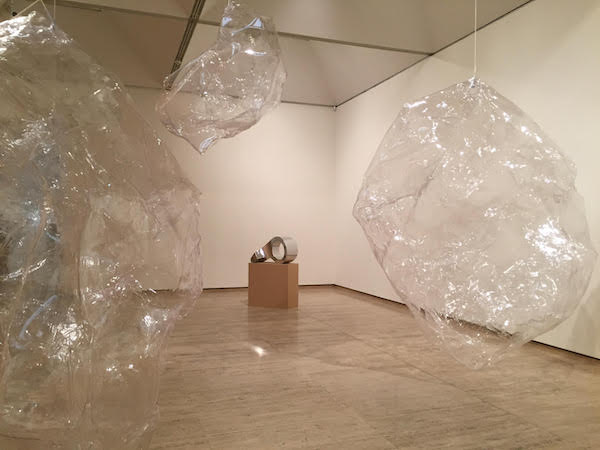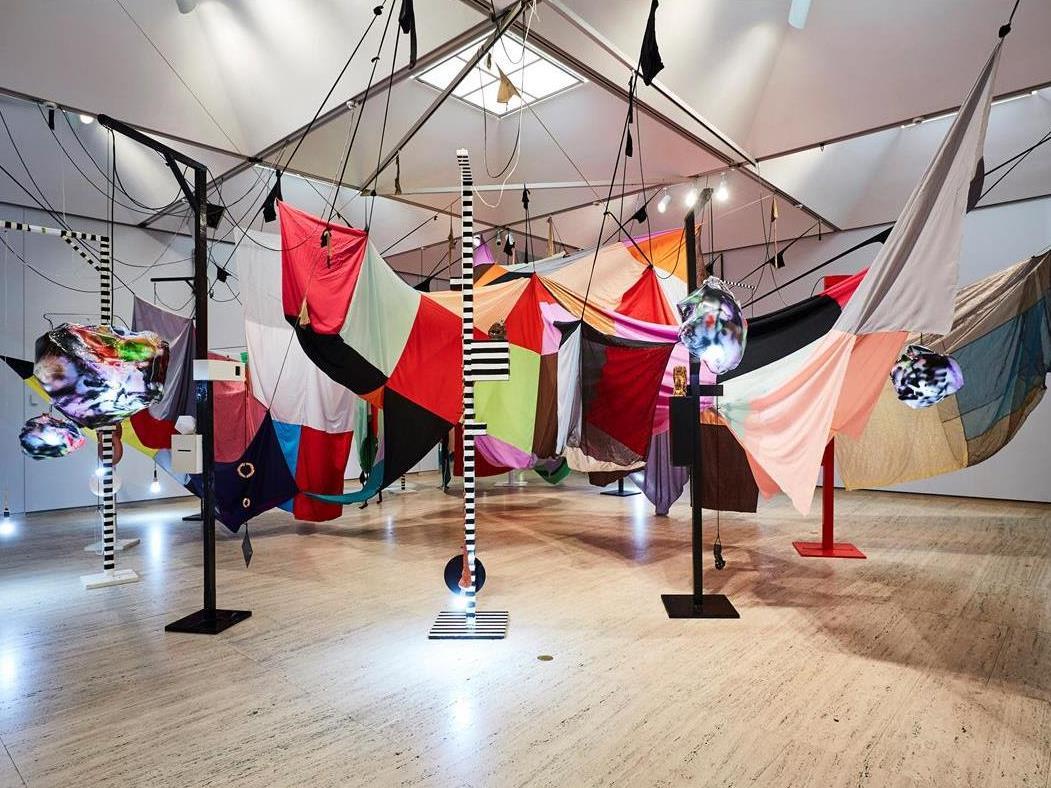Mikala Dwyer, Square cloud compound (2010) fabric stockings, glass, beer, champagne, plastic, ceramics, found things, wood, rocks, lights, paint, acrylic, cat and bird ornaments, dimensions variable © Mikala Dwyer; supplied
While some 26,000 people traipsed through Sydney Contemporary this past week, it was another exhibition in town that caught the eye of many – Mikala Dwyer’s solo exhibition at the Art Gallery of NSW (AGNSW) was touted in Instagram posts and opening night banter as ‘the thing to see’.
Curated by Wayne Tunnicliffe, the exhibition had opened just a week before Sydney Art Week hit town.
A shape of thought was not a conventional survey (in a climate where Sydney is headlining major shows by Jenny Watson, Hilarie Mais and Pat Brassington) but rather brought together new and recent works, and in the process unstitching our understanding of familiar objects.
The entree to that is the experience of descending the gallery’s escalator to the lower level, with a mushrooming of silver hovering above: a cluster of custom-made helium balloon tethered to – and playing off – the gallery’s architecture. Their use of the numeral zero suggests a void, but Dwyer is playing with concepts of volume and gravity and you are caught right in the middle of the game.

The silvering (2017) installation view AGNSW; Photo ArtsHub
Versions of this piece, The silvering, have been showing in Berlin, Melbourne, Brisbane, Dublin and Paris, underscoring Dwyer’s international exposure. We do not celebrate our Australian artists enough, those who put in the work to move their careers beyond our shores and establish themselves abroad.
The gallery writes: ‘Sydney-based Dwyer began exhibiting in the mid-1980s and has developed a distinctive and highly engaging international sculptural practice’. Dwyer spent time studying at Berlin University of the Arts, and immersed herself in working globally.
Dwyer’s major installation, Square cloud compound (2010, pictured top) sat centre stage at Art Basel Hong Kong in 2015, where it was purchased by the Museum of Contemporary Art Australia, and is on loan for this exhibition.
Viewers are forced to navigate their way through its tension wires, again anchored to the architecture and creating pockets of surprises with curious and loaded objects caught in the fold. What is this space sheltering – childhood dreams, our ideals, or creativity itself?
It occupies one of four galleries that present work of large scale; vibrant, engaging, sensuous in their materiality and damn right buzzy in their energy. But underlying the retinal pop and the bodily play, Dwyer explores more gritty and weighty topics.
Almost like bookends given their visual punch, at the other end of the Contemporary Galleries sits the installation, The letterbox Marys (2017), with its geometric banners draping long onto the gallery floor, and objects and stylistic cues that pay various nods to other artists, other histories and other religions. One gets lost in its dizzying appeal, and like candy to the eye and a stimulant to the brain, it’s an easy physical seduction.

Installation view, The letterbox Marys (2017) – the five banners titled L-R The angle (2015), Possession (2015), Sigil for Heaven and Earth (2015), Backdrop for rounders (2016) and Backdrop for base matter (2016); Photo Artshub

In between are the quieter works, A weight of space (2017), using clear plastic sheeting and a heat gun to create an organic form – not dissimilar to Dwyer’s Redlands Konica Minolta winning work of 2015 – while another gallery presents the circle installation, Divisions and subtractions (2017).
This installation of familiar objects take an unfamiliar outing in Dwyer’s hands, magically united and yet each carrying their own associations and triggers for memory. This is an incredibly elegant piece and demonstrates a refinement, and tight understanding of form and volume and the kinds of tension and play that can be created by simply placing two objects adjacent.

Installation view, Divisions and subtractions (2017) at AGNSW; Photo ArtsHub.
Dwyer gives a nod to fellow artists, including elements of their work within this installation, and playing off that idea of a “circle of friends” – edges with a cultish tone.
I love the snippet of knowledge that Dwyer’s father was an industrial chemist who worked with plastics and her mother was a modernist jeweler who worked with metals. You see that influence for a material passion across her work, but you also see her encyclopedic knowledge of international art history, and years of honing a very individual expression – it is a very clear pure love for the physicality of making and having a good chew conceptually on what those pairings throw up.
Dwyer first exhibited at AGNSW as part of Australian Perspecta 1993, what director Michael Brand described as memorably dressing the gallery’s vestibule columns ‘in gaudy sequin fabric and … the floor in rubber bath mats.’ Dwyer is still altering visitors’ perspectives through the everyday.
A shape of thought follows Julian Rosefeldt’s Manifesto as the second in a new series of exhibitions for the Gallery that present new and recent work by significant Australian and international contemporary artists. So far the line up is stellar! This is one of the better exhibitions I have seen this year and it is not to be missed.Rating: 4 ½ out of 5
Mikala Dwyer: a shape of thought
26 August – 4 February 2018
Art Gallery of NSW





